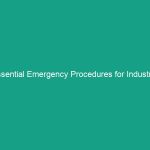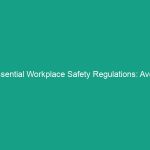Introduction
Good morning team! Today, we’re going to discuss an essential aspect of Workplace Safety: Conveyor Belt Entrapment Hazards. Understanding these Hazards is crucial for everyone working around conveyor systems, as they can pose serious risks if not properly managed.
This Toolbox Talk aims to highlight key Safety practices regarding guarding methods and emergency stops. By the end of our discussion, you’ll have a clearer understanding of how to keep yourselves and your colleagues safe while working around conveyor belts. Remember, safety is a shared responsibility, and your awareness can make a significant difference!
Understanding Conveyor Belt Entrapment Hazards
Conveyor Belt Entrapment Hazards refer to the risks associated with becoming caught or trapped in moving parts of a conveyor system. These hazards can lead to severe injuries, including amputations or fatalities, which is why understanding them is vital for your Safety.
These hazards are particularly relevant in industries such as manufacturing, warehousing, and distribution, where conveyors are commonly used for transporting materials. A common misconception is that these systems are safe as long as you stay clear of them. In reality, even being near a conveyor can be dangerous if proper Safety Measures are not in place.
Key Hazards, Risks, and Safety Considerations
Let’s dive into some specific hazards and risks associated with conveyor belt systems:
- Entrapment: This occurs when a body part becomes caught in the moving parts of the conveyor, potentially leading to serious injury.
- Pinch Points: These are areas where two parts of the conveyor come together, creating a risk of crushing injuries.
- Slips, Trips, and Falls: The area around conveyors can be cluttered or wet, increasing the risk of falls.
- Mechanical Failures: If guards or safety systems are not in place or fail, the risk of accidents increases significantly.
Ignoring these safety protocols could result in not only severe injuries but also potential downtime and financial losses for the company. Always prioritize safety to prevent these unfortunate incidents!
Best Practices, Procedures, & Actionable Advice
Now that we understand the risks, let’s discuss Best Practices to mitigate these hazards:
1. Proper Guarding
Ensure that all conveyor systems are properly guarded. Guards should be installed at pinch points, drive components, and areas where there is a risk of entrapment. Here’s how:
- Use fixed guards when possible, as they provide a permanent barrier against access to moving parts.
- For areas where access is necessary, use interlocked guards that automatically stop the conveyor when opened.
- Regularly inspect guards for damage and ensure they are correctly installed.
2. Emergency Stops
Having an effective emergency stop procedure is critical. Here’s what you need to do:
- Identify the location of all emergency stop buttons before starting work.
- Ensure that emergency stop mechanisms are functional and easily accessible at all times.
- Conduct regular drills to practice emergency stop Procedures. Familiarity can save lives!
3. Training & Awareness
Training is essential. Make sure you:
- Participate in all safety Training sessions related to conveyor operations.
- Be aware of the specific hazards associated with your work Environment.
- Encourage fellow employees to speak up about any safety concerns or suggestions.
4. Regular Maintenance
Regular maintenance of conveyor systems is crucial to ensure they operate safely. This includes:
- Scheduling routine inspections to identify wear and tear.
- Maintaining a clean work area around conveyors to prevent slips and falls.
- Documenting all maintenance activities for accountability.
5. Case Study: Real-World Incident
Consider a recent incident at a local warehouse where an employee’s hand was caught in an unguarded section of a conveyor. This resulted in a serious injury that could have been avoided with proper guarding and training. This incident emphasizes the importance of our discussion today!
Regulations, Standards, and Compliance
Compliance with safety Regulations is not just a legal necessity; it’s a moral obligation. Here are some key Standards to be aware of:
- OSHA Standards: The Occupational Safety and Health Administration sets forth regulations regarding conveyor safety, including proper guarding and emergency stop requirements.
- ISO Standards: International Organization for Standardization provides guidelines for safety in machinery, which include conveyors.
- Company Policies: Always adhere to our internal safety policies regarding conveyors and machinery Operation.
Understanding and complying with these regulations not only protects you but also fosters a culture of safety within our workplace.
Employee Engagement & Discussion
Now, I’d like to hear from you. What safety challenges have you encountered related to conveyor systems? Are there any particular areas where you feel we need to improve our safety practices?
Your input is invaluable in creating a safer work environment. Safety is a shared responsibility, and discussing these issues openly helps us prevent accidents.
Conclusion & Key Takeaways
To wrap up, here are the key points we discussed today:
- Understand the hazards associated with conveyor belt systems.
- Implement proper guarding and ensure emergency stops are functional.
- Participate in training and maintain awareness of your surroundings.
- Adhere to safety regulations and company policies.
By applying these practices, you can significantly reduce the risk of injuries related to conveyor belt entrapment hazards. Thank you for your attention and your commitment to safety! Let’s keep looking out for one another and make our workplace as safe as possible.


